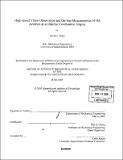| dc.contributor.advisor | Wai K. Cheng. | en_US |
| dc.contributor.author | Manz, Devon L | en_US |
| dc.contributor.other | Massachusetts Institute of Technology. Dept. of Mechanical Engineering. | en_US |
| dc.date.accessioned | 2006-03-29T18:37:20Z | |
| dc.date.available | 2006-03-29T18:37:20Z | |
| dc.date.copyright | 2005 | en_US |
| dc.date.issued | 2005 | en_US |
| dc.identifier.uri | http://hdl.handle.net/1721.1/32358 | |
| dc.description | Thesis (S.M.)--Massachusetts Institute of Technology, Dept. of Mechanical Engineering, 2005. | en_US |
| dc.description | Includes bibliographical references (p. 91-92). | en_US |
| dc.description.abstract | Along the oil's journey through the oil lube system, the oil lubricates, cools, removes impurities, supports load, and minimizes friction. At the end of the oil's journey it returns to the sump where it remains nearly motionless until it re-enters the oil pick-up and restarts its journey. This study is focused on the creation and destruction mechanisms of air in the oil. To study this, a motored Ford 3.OL V6 DOHC engine test apparatus was designed, fabricated and instrumented to operate at 8000rpm and at engine oil temperatures below 110ÌŠC. Visual observations and quantitative measurements of oil aeration were performed in the oil sump. The oil aeration process was visualized in the oil sump using high-speed video equipment, at engine speeds below 4000rpm. Oil droplets were observed to depart the crankshaft at approximately the tangential velocity, pass through drainage gaps in the windage tray, and strike the free surface of the oil. The rhythmic pulsation of oil droplets on the free surface caused the surface to slosh at the frequency of the crankshaft's rotation. Foam was observed to form above a threshold speed and a threshold temperature. The windage tray was observed to reduce the droplet number density. When the windage tray was removed, the increased droplet number density inhibited foam formation. An x-ray absorption measurement technique was used to measure oil aeration at multiple locations in the oil sump. An experimental methodology was developed and preliminary experiments were performed with and without the windage tray at oil volumes below 5L, engine speeds below 6000rpm, and oil temperatures below 110ÌŠC. | en_US |
| dc.description.abstract | (cont.) Aeration measurements reveal a general increase in aeration as a function of engine speed at all locations in the oil sump. In the oil sump, more air is present at the oil surface than at the oil pick-up because air continuously leaves the oil at the air-oil interface. When the engine shuts down, all of the oil in the lube path drains back into the oil sump, and in a short period of time all of the air bubbles rise to the surface and escape the oil. It is the balance between air entering the oil (creation mechanisms) and air leaving the oil (destruction mechanisms) that is the focus of this study. | en_US |
| dc.description.statementofresponsibility | by Devon L. Manz. | en_US |
| dc.format.extent | 92 p. | en_US |
| dc.format.extent | 6197802 bytes | |
| dc.format.extent | 6202250 bytes | |
| dc.format.mimetype | application/pdf | |
| dc.format.mimetype | application/pdf | |
| dc.language.iso | eng | en_US |
| dc.publisher | Massachusetts Institute of Technology | en_US |
| dc.rights | M.I.T. theses are protected by copyright. They may be viewed from this source for any purpose, but reproduction or distribution in any format is prohibited without written permission. See provided URL for inquiries about permission. | en_US |
| dc.rights.uri | http://dspace.mit.edu/handle/1721.1/7582 | |
| dc.subject | Mechanical Engineering. | en_US |
| dc.title | High-speed video observation and on-line measurements of oil aeration in an internal combustion engine | en_US |
| dc.type | Thesis | en_US |
| dc.description.degree | S.M. | en_US |
| dc.contributor.department | Massachusetts Institute of Technology. Department of Mechanical Engineering | |
| dc.identifier.oclc | 61493939 | en_US |
